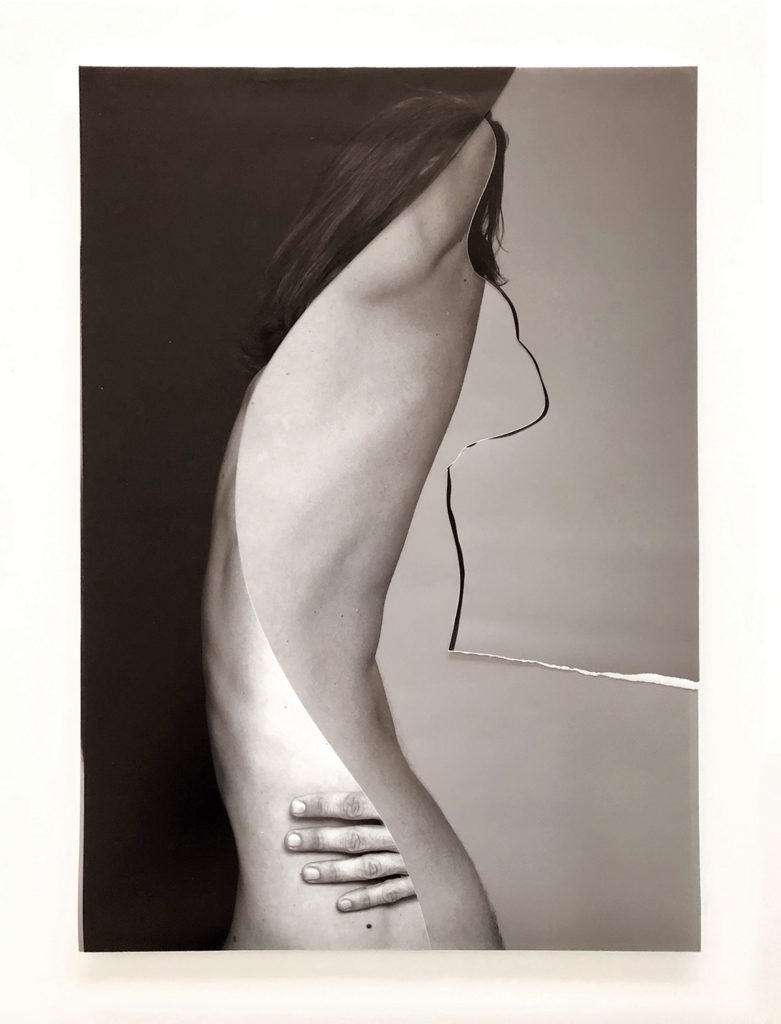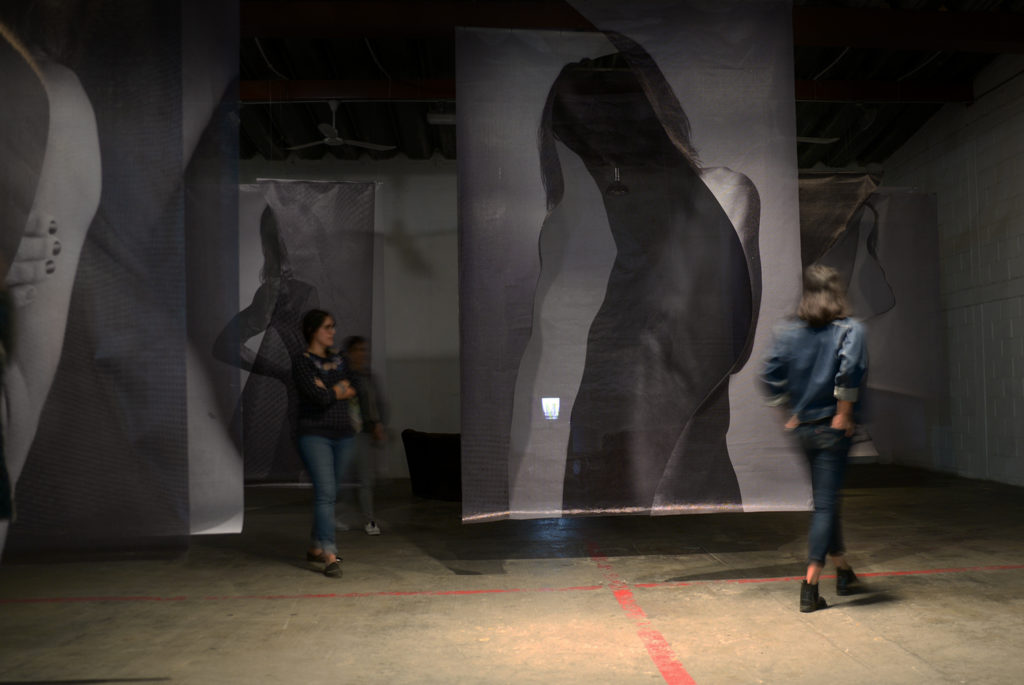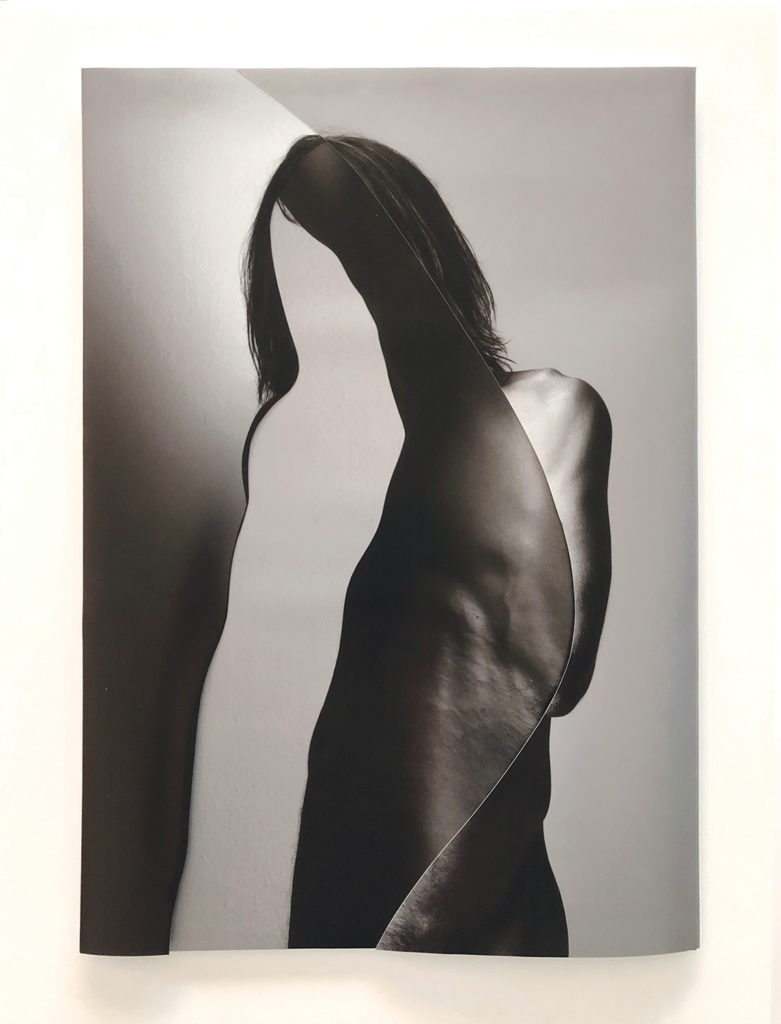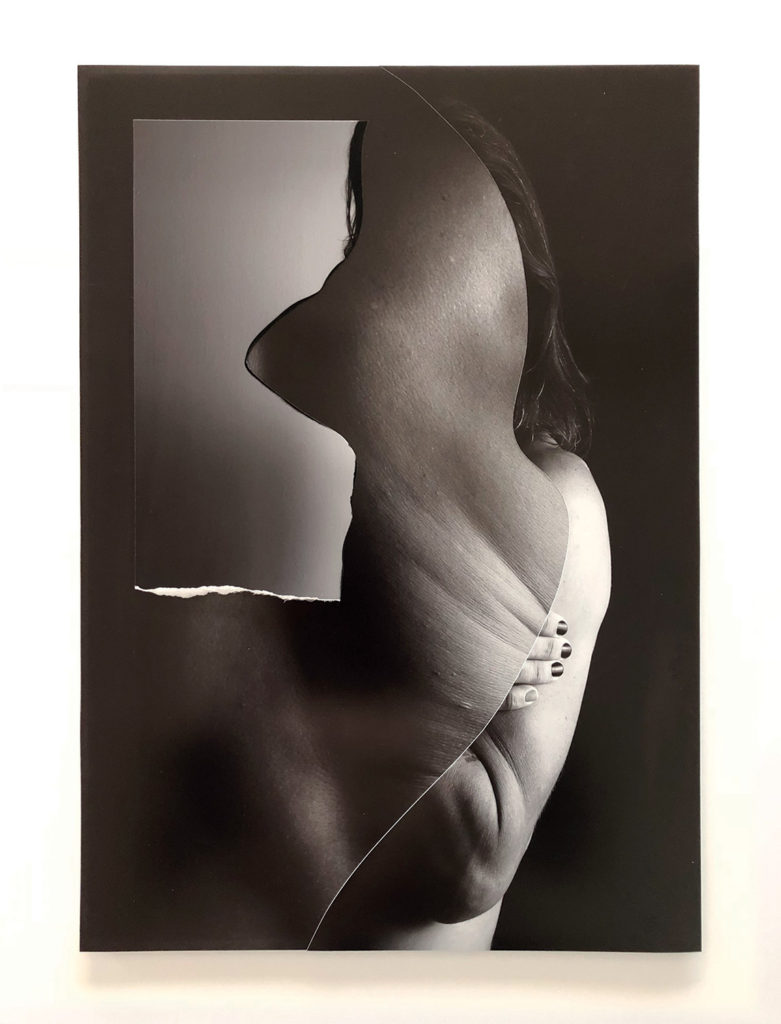Gender, collage as medium and artistic collaborations, among other things, are key elements to have a deeper understanding of his most recent solo show.
Can you please tell us about your most recent project, Reflejadx, exhibited in Oaxaca, México?
The work is basically about looking inside your self and revealing the vulnerabilities that we all try to keep hidden. Kind of like that feeling of standing naked in front of a mirror. That’s how the name came about, which translates to Reflected in English. I actually first did the show on a smaller scale in Australia in July 2018 at China Heights gallery. Then took it to México in November to present at Taller Espacio Alternativo in Oaxaca city.
Using the ‘x’ in place of ‘o/a’ on Reflejadx made a lot of sense for the title in México, as it’s become a common way to play with masculinity and femininity in Spanish language. One of the key themes of this work is about exploring gender, and flipping or removing male and female concepts. My intention was to cut and reassemble photographic portraits to become unrecognizable. I wanted to challenge the viewer’s preconceived ideas of gender, but also what is considered beautiful in terms of the body.

Reflejadx defies the traditional idea of collage in many ways. The first that struck us is that you broke with collage´s tradition of working with found material. Can you tell us about why you chose to do it this way. And also can you tell us about your collaboration with photographer Tanja Bruckner?
Truthfully, I think the idea was originally planted when I was lucky enough to be at one of the Weird Show Assemblage Gatherings in July 2017 at Mike De Sutter’s studio in New York. As you know we were asked to discuss what collage is and where it is going in the future. At one point the conversation turned to the idea that all these old magazines are one day going to disappear and what that meant for us. We also talked about copyright and using other people’s photos etc. Which just got me thinking.
When I got back to my studio in México I was working on a solo exhibition and continued using my collection of old magazines. But while I was creating this new work the idea remained in my head. I remember thinking about why I used images of women to express my own feelings, which I decided was because I don’t really relate to the images of men in magazines, as they always appear very ‘machismo’. My artworks explore various themes but always with a feminine approach. It was around then that I began to think about shooting photos of models and my immediate thought was to use women for that reason. I did think about using my own body as well, but I was pretty scared to raise the idea with anyone at first.
I’ve known Tanja Bruckner since we were teenagers. We lost contact for a few years, but recently found each other again and have become very close. So when I had the idea that I might want to be photographed naked by someone, she was the only person I really trusted. In fact I knew she would be pretty hyped on the concept, and she was. The whole process was really important for her as well. She comes from a background of fashion photography, which is dominated by male photographers shooting semi-naked or naked women in vulnerable situations. For her it was an opportunity to flip the whole thing around. I really believe this is why it worked. We both had something to gain and learn from the experience. The original photos themselves are actually pretty intriguing and beautiful on their own. She’s posted a few of them on her instagram.

Why was it important for you to be the one portrayed by the photographer and collaged by yourself?
I talked to Tanja and another good friend of ours about my idea and both of them came back to me asking why I would shoot models if I wanted to express my own emotions. They agreed that it would be much more personal and powerful if I was the subject. It was also obvious that I was heading down the classic patriarchal path of male artists exploiting women’s bodies for their own purpose had I used a female model.
Being photographed naked wasn’t really an issue. I was a little concerned that people would think I had become kind of self-obsessed. But mostly I would be opening up about my gender fluidity and the truth that I am far more connected to a feminine idea of myself, and I had chosen to expose it in the most public way.

What’s really interesting is this fear became really important to the concept. I realized what I also wanted to achieve was to ask men to look at an image of a naked man without it threatening their sexuality. Which is something women are faced with on a daily basis through all forms of media, advertising and pornography etc.
The result was that the majority of both men and women viewing the artwork assumed that the model was a woman. Also several men came to me during and after the exhibition and told me that they thought the images were really incredible, but had at first thought it was a female. I think that we just automatically associate a picture of what is considered a ‘traditionally’ beautiful figure with being female, and I wanted to challenge that idea. This to me has been the most successful part of doing the project.
Another rupture with traditional collage is the one related with the reproduction of your artworks. In the exhibition you show the original collages and giant layered reproductions. Does size and depth help you to deliver your message in a more effective way?
Yeah, for sure. They’re just instantly more impressive and mind blowing to look at. To be able to walk inside a giant artwork is a strange feeling for a person who is accustomed to being told not to go near or touch art. Galleries are intimidating spaces for the average person. I really enjoyed breaking from this tradition as well. For Reflejadx I invited people to literally walk inside and through the artworks. It’s interesting to watch them interact with the space. You can tell they’re intimidated at first, probably by the scale, but also by the idea that they can go in and touch things and in essence become part of the exhibition.
I came about the idea of going large-scale when I did a solo exhibition in Oaxaca in late 2017. The space had a giant glass atrium in the entrance. I’d already been playing with more three-dimensional collaging techniques. Raising layers on foam board so you could see a little more of the images behind. At some point I’d started to hang them loosely and only attach them at the top, so they kind of hung like curtains. This later seemed like the easiest way to make a giant 3-D collage. So I literally just scaled up one of my artworks and hung each separated layer from an open ceiling. It was fairly crude but it worked and definitely led me to doing Reflejadx the way that I did.
Making that first large piece got me thinking about how we hide and reveal things by using layers in collage. But also in real life we tend to keep certain thoughts or beliefs inside while there are other things we are happy to share or talk about. This became really important in the large-scale artworks of Reflejadx. I discovered that I could cover parts of the naked body and make abstract shapes to the point of almost being unrecognizable as human. By separating each layer about 50cm, then walking around them, other shapes and lines are revealed, bringing a whole new visual concept from within the original picture. The artwork changes, depending on where you stand. I’ve recently started looking at introducing augmented reality as a potential next step. But haven’t really done anything with that yet.

Why did you decide to show both original and rescaled versions?
To be honest at first I was still thinking in terms of traditional exhibitions in galleries, which was what I had always done until now. Basically I was keeping the artworks accessible to the audience and trying to sell them while still doing the installation. Although, I think I am now headed more toward only showing the large-scale artworks in future and not creating framed pieces at all.
Interestingly the process I use to make the rescaled versions is basically the same as I have always worked. I start by printing out the original photos on A3 paper. I cut them up and play with them until I get an artwork I’m happy with. At that point I have a collage that could be framed as is. But then I go back and scale the photos up to whatever size I want the final large piece to be and print them and cut them exactly as I had on the original artwork. It’s still very much a hand made process. None of the collage work is done digitally. It’s really just a way of working more economically and practically. It would be really expensive and difficult to be experimenting with 2x3m prints from the beginning.



In the giant layered versions the notion of classic collage is defied. Are you intentionally questioning collage as a technique? As if somehow you are trying to change or modify the way we know and make collage?
That’s an interesting question. I have wondered lately if I am actually even a collage artist anymore or if this is more like performance art. I’m still not sure where I’m going with this, but I am really enjoying the process and I am getting incredibly positive response to the work. So I will keep pushing it for now.
The thing I like about collage is that there are no strict rules. Obviously there are traditions, but as you are aware there are artists all over the world really pushing the boundaries of what collage can be. If it’s defined most simply as a collection or combination of various images or things assembled to make a new image. Then what I am doing would still be considered collage. I cut up photos and assemble them together to make an artwork. They just don’t fit on an average cutting board.
I don’t think I went into this with the intention of pushing the boundaries of collage so much. For me it’s more important to challenge my self and the viewer. Once I discovered this technique of working large-scale I realized that I was questioning collage traditions and have since been thinking more about what that means. Is this collage? Is it performance? Do I even need to put a label on it? For now this new project is just really fun, challenging and very unique.
I have wondered lately if I am actually even a collage artist anymore or if this is more like performance art. I’m still not sure where I’m going with this, but I am really enjoying the process
Steven Tierney

You are based in México and Australia. How have these different contexts informed your work and influenced it?
I’ve thought about this a lot and it’s not an easy answer. I am aware that both cultures have influenced me hugely in my art practice as well as my way of life. Australia is where I grew up and so I am very much from that place. But since I have spent more time living in México recently, I now feel very attached to that place and the culture. In terms of informing my work, I believe it’s more my artistic process rather than the visual content that has been influenced by México. The artists’ I know and collaborate with there, as well as the overall energy that exists in the region has influenced me immensely.
Seeing the way artists’ work and express themselves, in Oaxaca especially, has given me confidence to be more conceptual and free to experiment. The Australian art scene, in terms of what is selling at least, is pretty conservative in my opinion. Popular art in Australia continues to be landscapes, portraits and this kind of quirky ‘Australiana’ iconography, which I have no interest in making. Of course there is Indigenous art. But that is something else, and is very important. But as I’m not Indigenous Australian I don’t necessarily see how that would inform my own directly.
Obviously there are loads of great artists creating really experimental art in Australia. But for some reason I felt much more comfortable showing this exhibition in México, than in my own country. Which is why I was able to do Reflejadx the way that I did. Although, I am going to be living in Australia most of this year and plan to do more here, so I’m hoping to be proven wrong on that.




